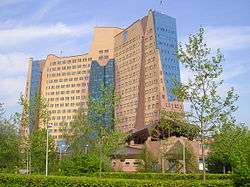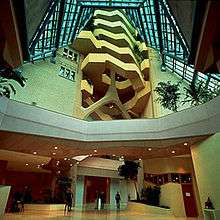Gasunie Building
| Gasunie Building | |
|---|---|
 Gasunie Building | |
 Location within Netherlands | |
| General information | |
| Town or city | Groningen |
| Country | Netherlands |
| Coordinates | 53°12′4″N 6°33′5″E / 53.20111°N 6.55139°ECoordinates: 53°12′4″N 6°33′5″E / 53.20111°N 6.55139°E |
| Opened | 22 April 1994 |
| Height | 89 metres (292 ft) |
| Technical details | |
| Floor count | 18 |
| Design and construction | |
| Architect | Alberts & Van Huut |
The Gasunie Building is one of the most famous buildings in Groningen. It was built as a headquarters for Gasunie and was officially opened on 22 April 1994 by Her Majesty Queen Beatrix of the Netherlands. The building has 18 floors and is 89 metres (292 ft) high, which makes it the second tallest building in Groningen after the Martinitoren. It is situated in the south of the city, on the edge of the Stadspark and right next to the main highways. It is also considered one of the most beautiful office buildings in the Netherlands.
History
When the old Gasunie building facilities could not meet the needs of growing number of the employees, the necessity for a new office emerged. After evaluation of the economical and practical issues of the project, a decision to build a completely new building was made. Eventually, the project started in 1989 with selecting a suitable site and creating a list of requirements, which architects should have implemented in their proposals.
Architecture

The design of the building was developed by Alberts & Van Huut architects bureau and is considered to be a great example of ‘organic building’. There are two distinct parts in the building: high-rise section with offices and low-rise section with meeting rooms and service facilities. One of the main features of the building is its unique stairwell with glass ‘waterfall’ which is 60 metres (200 ft) high and 40 metres (130 ft) wide. The floors of the building are visually linked by this glass wall, which creates a sense of unity and space. All the way up the main stairs are surrounded by, so called, hanging gardens.
External links
 Media related to Gasunie building at Wikimedia Commons
Media related to Gasunie building at Wikimedia Commons- Gasunie-gebouw
- - Newspaper ″Trouw″ 2007 -Most beautiful building in Groningen-